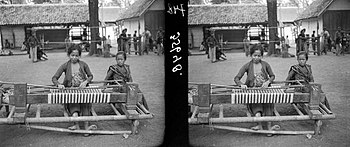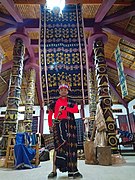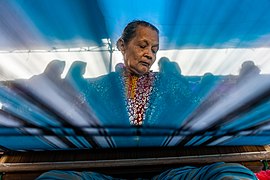 A traditional weaver from Sumatra A traditional weaver from Sumatra | |
| Type | Art Fabric |
|---|---|
| Material | Silk, cotton, gold, silver |
| Place of origin | Indonesia |
| Manufacturer | Indonesians |
Tenun is an artful Indonesian technique of making a fabric by weaving different colours of threads. Tenun belongs to one of the typical Indonesian cultural arts produced by hand skills using traditional looms. The word Tenun itself has a high meaning, historical value, and technique in terms of colors, motifs, and types of materials and threads used and each region has its own characteristics. In addition, Tenun is also one of Indonesia's original cultural heritages that is still maintained and preserved to this day.
Tenun fabrics are made in various places in the Indonesian archipelago such as on the islands of Sumatra, Java, Bali and Sulawesi, where each region has its own uniqueness and characteristics in terms of motifs and colors. These differences are caused by geographical location, beliefs, customs and the surrounding natural conditions including flora and fauna, each region has certain differences and uniqueness as well as contacts or relationships between regions, from the many types of Tenun, ikat and songket are the most famous, even tenun ikat is well known and popular in many countries.
Since 2010, various Tenun traditions practiced throughout Indonesia officially recognized and regarded by the Ministry of Education, Culture, Research, and Technology of Republic Indonesia as integral part of the National Intangible Cultural Heritage of Indonesia.
Etymology
The technique of weaving cloth was brought to Insular Southeast Asia (ISEA) as a result of the Austronesian expansion. The word tenun goes back the reconstructed Proto-Austronesian form *tenun 'to weave (cloth)', which is widely attested in Taiwan and ISEA.
History

Tenun fabrics are thought to have existed since the Neolithic period. This has been proven by the discovery of prehistoric objects, such as woven stamps, tools for spinning, and materials that are clearly woven on cloth made of cotton, which are more than 3,000 years old at the East Sumba site, Gunung wingko, Yogyakarta, Gilimanuk and Melolo.
In the Neolithic period, the materials for making clothes were still very simple, such as fibers, leaves, bark, animal skins, and plant roots. The manufacture of clothes from bark must choose a type of tree that is hard and has long wood fibers, then the tree is skinned, then the wood fiber is soaked in water to make it soft. Then use a bat in the form of a stone to shape the bark into cloth. The remnants of the tradition of making this kind of cloth are still found in the area of Central Sulawesi called Fuya and in Papua called Capo.
In Old Javanese inscriptions, terms can be found that describe the existence of weaving in the past. On the Karang Tengah inscription dated 847, there is the inscription "white hlai 1 (one) kalambi" which means one piece of white cloth and clothes. In the "Baru" inscription in 1034 AD the word Pawdikan means batik or weaver. In the "Tebu" inscription in 1021 AD and the inscription from Singhasari in 929 AD there is the term "makapas" or cotton. In folklore that has to do with weaving is the story of Sang Kuriang, an important character in the story, Dayang Sumbi, whose daily job is weaving. The manufacture of clothing in the past can be traced to the relief Perempuan menenun ("women are weaving") carved on a 14th-century stone pedestal from the Trowulan area, now stored in the Trowulan Museum, East Java.
In South Sumatra, songket weaving has existed since the seventh century. Based on the analysis conducted on the statues at the Bumiayu temple, it can be seen that songket has been worn by the people of South Sumatra since the seventh century AD, when Srivijaya was based in Palembang. This statue was found at the Bumiayu Temple Archaeological Site which is located on the downstream bank of Lematang River which empties into Musi River, precisely in Tanah Abang District, Penukal Abab Lematang Ilir district approximately 120 kilometres (75 mi) to the west of Palembang City.
Technique
Tenun techniques can be divided into two major groups, namely techniques in making cloth and techniques for making decorations. In addition, there are two other things that are very important in making tenun, namely preparing the manufacture of yarn and making dyes. Traditionally, yarn is made using weights that are rotated with the fingers (Javanese: diplintir), the ballast is shaped like a top made of wood or terracotta. In western Indonesia (Sumatra, Java, Bali, Lombok) there is another way to make yarn using "Antih," this tool consists of a wide wheel that can be turned along with a dial (ontel) to turn the wheel. The manufacture of dyes in the past consisted of two colors blue and red. The blue color is obtained from indigo or Mirinda Citrifonela or noni. In addition there are dyes from other plants such as Achiote.
Type of Tenun
- Several types of traditional Indonesian woven fabrics
-
 Tenun Baduy
Tenun Baduy
-
 Bentenan
Bentenan
-
 Cepuk
Cepuk
-
 Endek
Endek
-
 Geringsing
Geringsing
-
Hinggi
-
 Ikat
Ikat
-
 Kamohu
Kamohu
-
 Kumbu
Kumbu
-
 Lamak
Lamak
-
 Lau
Lau
-
Limar
-
 Lunggi
Lunggi
-
 Lurik
Lurik
-
 Sasak
Sasak
-

-
Pagatan
-
 Palepai
Palepai
-
 Porilonjong
Porilonjong
-
 Kain Pua
Kain Pua
-
 Tenun Samarinda
Tenun Samarinda
-
 Songket
Songket
-
 Tenun Sora
Tenun Sora
-
Tais
-
 Tapis
Tapis
-
 Tenun Troso
Tenun Troso
-
 Uis
Uis
-
 Ulap Doyo
Ulap Doyo
-
 Ulos
Ulos
See also
References
- ^ Kahdar, Kahfiati; Jay, Sian E. (2010). Tenun: Handwoven Textiles of Indonesia. Tuttle. p. 191. ISBN 978-602-97473-0-0. Archived from the original on June 18, 2022.
- Kartiwa, Suwati (2009). Tenun Ikat: Indonesia's Ikat Weaving Traditions. National Library of Australia.
{{cite book}}: CS1 maint: location missing publisher (link) - "Tenun: Indonesian Ikat Fabric – Kinds and Art of Weaving Threads". Retrieved 6 January 2022.
- Indonesia, Cita Tenun (10 September 2011). Tenun: Handwoven Textiles of Indonesia. Tuttle. ISBN 9786029747300. Retrieved 7 January 2022.
- "Textiles of Indonesia". Retrieved 7 January 2022.
- "5 Traditional Indonesian Fabrics and the Stories behind Them". ndonesia.travel. Retrieved 7 January 2022.
- "Inilah 9 Jenis Kain Tenun Tradisional Nan Eksotis Kekayaan Indonesia Yang Perlu Anda Ketahui". kemenperin.go.id (in Indonesian). Retrieved 7 January 2022.
- "Diplomasi Batik, Sejarah Panjang Tenun Keragaman". indonesia.go.id (in Indonesian). Retrieved 7 January 2022.
- "Tenun". Ministry of Education, Culture, Research, and Technology of the Republic Indonesia. 2010.
- Buckley, Christopher (2017). "Looms, Weaving and the Austronesian Expansion". In Andrea Acri; Roger Blench; Alexandra Landmann (eds.). Spirits and Ships: Cultural Transfers in Early Monsoon Asia. Singapore: ISEAS Publishing. pp. 273–324. doi:10.1355/9789814762779-009. ISBN 9789814762779.
- "Pengertian Menenun dan Sejarahnya". kumparan.com (in Indonesian). Retrieved 7 January 2022.
- "Kain Tenun" (PDF). undikssha.ac.id (in Indonesian). Retrieved 7 January 2022.
- "Sejarah Kain Tenun". indonesia.go.id (in Indonesian). Retrieved 7 January 2022.
- "Mengenal Sejarah Proses Pembuatan Kain Tenun di Sikka Flores". kompas.com (in Indonesian). 14 April 2019. Retrieved 7 January 2022.
External links
 Media related to Tenun at Wikimedia Commons
Media related to Tenun at Wikimedia Commons
Bibliography
- Indonesia, Cita Tenun (2010). Tenun: Handwoven Textiles of Indonesia. Tuttle. p. 191. ISBN 978-602-97473-0-0. Archived from the original on June 18, 2022.
- Tenun Ikat: Indonesia's Ikat Weaving Traditions. National Library of Australia. 2009.
{{cite book}}: CS1 maint: location missing publisher (link)
| Clothing identified with Indonesian culture and still worn today | |
| Textiles and weaving | |
| Dyeing | |
| Clothing |
|
| Headgear | |
| Jewelry and ornaments |
|
| Armour | |
| Footwear |
|